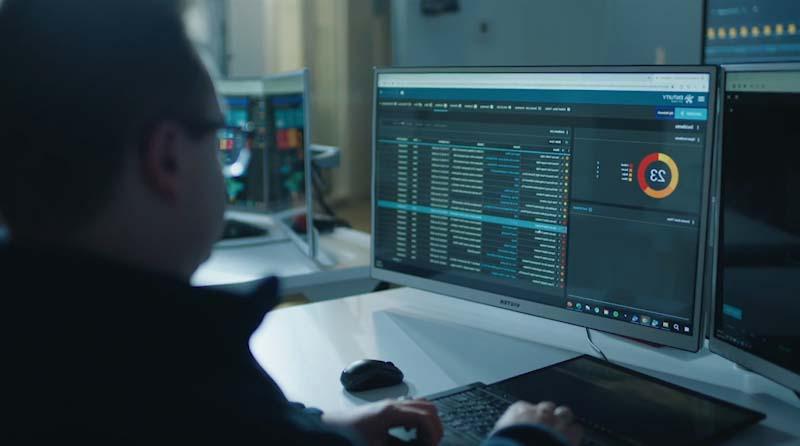IT Infrastructure Management Challenges
Park Place Managed Services
Managing an IT infrastructure, whether it’s a single data center or a network of global hubs, is difficult.
Ensuring Uptime is vital for organizational success, but it often comes with significant pressure and difficulties. It’s important to understand the most prominent IT infrastructure management challenges, as well as solutions to these issues, to keep your operations running efficiently.
What is IT Infrastructure Management?
Why Organizations Need IT Infrastructure Management?
Top 10 IT Infrastructure Challenges
1. Aligning IT Infrastructure Management with Business Goals
3. Increasing Software Complexity
8. Staffing the Correct Individuals
Considerations of Evolving Technology and It Infrastructure Management
IT Infrastructure Management Solutions
Outsourced Infrastructure Management from Park Place Technologies
What is IT Infrastructure Management?
IT Infrastructure Management is the management of hardware, software, and other systems that are necessary for delivering IT services, as well as management of all data center and cloud resources.
It is also essential for promoting digital transformation projects, fostering innovation, and ensuring company continuity.
Why Organizations Need IT Infrastructure Management
Organizations need IT Infrastructure Management for Uptime. Uptime ensures continuous delivery of services 24/7, 365 days a year.
This is important for organizations, as their services must continue to run smoothly and effectively, and be always available.
To ensure Uptime, IT teams must patch any weaknesses in their infrastructure as soon as possible. What is a weakness in the IT infrastructure? The top 10 infrastructure challenges and weaknesses are listed below.

Top 10 IT infrastructure Challenges
A well-managed infrastructure is critical for optimal IT operations; however, they are complex by nature and come with a variety of challenges. Below, difficulties are highlighted, as well as IT infrastructure management solutions for each difficulty.
1. Aligning IT Infrastructure Management with business goals
Challenge
A major challenge today is the idea that IT initiatives and business goals have differing priorities and objectives. This can lead to these organizational units not supporting each other, which creates a gap between IT infrastructure management and the business.
Solution
IT-business alignment helps ensure the business can meet key performance indicators. Increase the amount of communication between IT resources and the business. Move to metrics that are business-focused, like ROI and revenue, to help measure IT performance in terms of business goals.
Additionally, be sure that long-term strategic planning of IT infrastructure aligns with desired business outcomes so the organization uses the right technology at the right time.
2. Cybersecurity
Challenge
One of the main challenges of managing IT infrastructure processes is providing continuous protection as the number, intensity, and sophistication of outside cyber-attacks continue to grow.
Exposing data can have serious risks to the business as well as personal information.
Solution
Remaining vigilant is key. Organizations must assume a cyberattack is imminent and not only build a unified, integrated defense that best protects all relevant infrastructure assets, but also constantly evolve that defense to protect new attack surfaces within the infrastructure.
24/7 monitoring and proactive threat detection are essential. Keep hardware and software updated and current. Regularly update security protocols and educate employees on best practices. Focusing in these areas can help safeguard sensitive data and protect against security breaches.
3. Increasing Software Complexity
Challenge
One of the main IT infra issues is keeping up with the rapid pace of software development in IT infrastructures.
Integrating new software with existing infrastructure can be a daunting task, but it’s important that hardware and software continue to perform and don’t become obsolete with technological advancements.
Solution
Take care to ensure infrastructure software is not only compatible but secure as well.
If it is necessary or desirable to move workloads from existing infrastructure to the cloud be mindful of application performance. Path-tracing tools can be very helpful in planning whether to deploy to existing infrastructure or specific cloud resources.
4. Automation
Challenge
Infrastructure automation plays a vital role in reducing human error and improving efficiency. However, streamlining IT operations through automation can be challenging as it requires careful planning, standardized processes, and strong integration capabilities.
Solution
First, identify routine tasks that can likely be automated. Next, determine the tools and processes required to automate these tasks with reliability and security in mind. Partners can be useful here as the right partner will have resources familiar with the automation toolsets being considered.
This alleviates the challenge of acquiring new skills in-house and increases team productivity by freeing up IT personnel to focus on strategic initiatives instead of repetitive tasks. This also improves the employee experience as an added benefit.
5. Scalability
Challenge
Anticipating and accommodating growth within the infrastructure. Ensuring environments can scale along with increased user traffic and data volumes is vital – if not managed properly, this can lead to downtime.
Solution
Develop a well-defined strategy that not only accommodates growth but maintains system performance and reliability for on-prem, cloud, and hybrid infrastructure.
6. Data Management
Challenge
Inefficient data management can result in data loss, reduced productivity, and increased costs.
Solution
Develop a data management strategy, as organizations need a clear understanding of what data is important and how it is used.
Implement data management frameworks and tools to help ensure data accuracy, consistency, and reliability. Becoming efficient in this area can help organizations make better decisions and improve operations.
7. New Technology
Challenge
New technologies emerge at a rapid pace and keeping your data center up-to-date and relevant can be a constant battle. In recent times this has emerged as one of the key challenges of managing IT infrastructure processes.
Solution
Build with adaptability in mind. Choose components that can be easily upgraded and opt for platforms that actively keep pace with technological advancements.
Migrate from legacy systems where possible and leverage cloud providers while considering hybrid solutions where more flexibility is required.
8. Staffing the Correct Individuals
Challenge
Finding and retaining talent can be difficult. Today’s IT workforce is not only diverse and global but also fragmented and opens many opportunities for remote work – this can make it hard to fill available roles. In addition, retaining talent has also become a real challenge.
Solution
Outsourcing some IT infrastructure management tasks can help, but it is also important to retain employees who have strong familiarity with the business’s goals.
To limit employee attrition, offer well defined career paths and rewarding work experiences, as well as foster a culture of continuous learning. This empowers employees to own their careers and become more versatile.
9. Bridging the Skills Gap
Challenge
Addressing skills gaps in infrastructure management team.
Skills gaps can emerge from a variety of situations. Whether it’s a longtime employee leaving the organization or a shift to a new technology or platform, these gaps must be filled to keep the infrastructure up and running.
Solution
The first step to alleviate skills gaps is identification – assess the infrastructure for gaps and opportunities for improvement. Although some gaps will be obvious, others make take some investigation through audits or surveys.
Next, invest in training and development, to help the staff acquire or update the skills necessary to manage the infrastructure. As mentioned above, this can also help with employee retention.
Finally leverage external resources. Outsourcing some infrastructure tasks can help save time, money, and effort accessing specialized skills that you may not have in-house.
10. Budget constraints
Challenge
Overcoming the financial burden of maintaining and upgrading equipment can be a significant hurdle.
Solution
No.1 on this list can help here – Aligning Infrastructure Management with business goals. This allows us to frame modernization initiatives as strategic investments as opposed to costs, focusing on new capabilities and improved efficiency highlight the potential for long-term savings and increased revenue.
In addition, try to leverage cost-effective solutions including service providers to provide flexibility and scalability to the organization.
Considerations of Evolving Technology and IT Infrastructure Management
Organizations are constantly faced with evolving technology, which is a significant consideration when it comes to managing IT infrastructure processes.
Evolution in the following technologies has given way to opportunities to improve infrastructure management.
- AI and Machine Learning – These technologies enable predictive analytics, allowing teams to anticipate IT infrastructure issues and optimize performance. They can also automate incident response and improve decision-making.
- Cloud Computing – The shift to cloud services allows for scalable infrastructure. Organizations can quickly adjust resources based on demand, enhancing flexibility and cost management.
- Containerization and Microservices – Technologies like Docker and Kubernetes promote more modular application development and deployment, simplifying infrastructure management and improving resource utilization.
- Security Enhancements – Evolving cybersecurity technologies, such as AI-driven threat detection, improve the ability to protect infrastructure. This requires continuous adaptation and monitoring of security protocols.
- Next-generation Network Management – Software-defined networking (SDN) and network functions virtualization (NFV) enable more agile and efficient network management, allowing for dynamic configuration and better resource allocation.
- DevOps Integration – Evolving methodologies like DevOps encourage collaboration between development and operations teams, fostering continuous integration and continuous delivery (CI/CD) practices that enhance deployment speed and reliability.
- Remote Management – As remote work has become more common, tools for managing IT infrastructure tasks from anywhere are critical. This includes enhanced remote monitoring and management capabilities.
- Sustainability – With a growing emphasis on sustainability, IT infrastructure management must adapt to greener technologies, such as energy-efficient data centers and practices that reduce the environmental impact of IT infrastructures.
As technology evolves, IT infrastructure management becomes more dynamic, requiring a focus on automation, agility, security, and data-driven decision-making. Organizations need to stay ahead of these changes to maintain a competitive advantage.
IT Infrastructure Management Solutions
Ensuring the smooth and efficient operation of technology systems within an IT infrastructure is crucial for improving performance, reducing costs, and enhancing security.
When selecting an IT infrastructure management solution, consider factors like scalability, integration capabilities, ease of use, and 24x7x365 vendor support. Asolution tailored to fit your organization’s specific needs will help maximize its effectiveness.
Below we explore two key solutions to improve IT infrastructure operations.
Managed Services Providers
Outsourced Managed Services Providers (MSPs) are the ideal solution to tackle any infrastructure management challenges. MSPs can provide services such as bolstering short-staffed teams to bridge any skills gap issues, or full management services like running an entire IT stack. Depending on requirements, an outsourced partner can improve IT operations considerably.
When opting for an external Managed Services Provider, it’s important to note that reputable partners provide their own tools too, such as monitoring software. In this example, it is highly likely that the outsourced partner will also offer NOC-as-a-service, where they can provide live alerts on problems in the IT environment and then triage these infra issues. However, MSPs can also provide solutions that go beyond NOCaas, such as remediation and patching – depending on the infrastructure management challenges experienced, this could be more suitable.

Software Licenses
External software tools allow IT operations to remain with the in-house infrastructure team, but with access to tools that can enhance their infrastructure performance.
For example, network monitoring software, such as Entuity Software™, gives NetOps teams greater insight into network performance, without leveraging a Managed Services Provider.
Outsourced Infrastructure Management from Park Place Technologies
IT infrastructure issues can arise without warning. However, with Park Place Technologies’ Managed Services’ expertise, businesses can offload the management of their IT processes, ensuring optimal performance and reliability while freeing up internal resources to focus on core business objectives.
Park Place’s comprehensive suite of Infrastructure Managed Services covers everything from OS and hypervisor monitoring to full management of your environment, allowing streamlined operations and reduced downtime.
Contact us today to find out how we can help.



